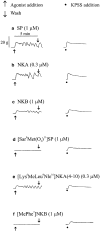Tachykinins and tachykinin receptors in human uterus
- PMID: 12788812
- PMCID: PMC1573878
- DOI: 10.1038/sj.bjp.0705279
Tachykinins and tachykinin receptors in human uterus
Abstract
(1) Studies were undertaken to determine the nature of the receptors mediating contractile effects of tachykinins in the uteri of nonpregnant women, and to analyse the expression of preprotachykinins (PPT), tachykinin receptors and the cell-surface peptidase, neprilysin (NEP), in the myometrium from pregnant and nonpregnant women. (2) The neurokinin B (NKB) precursor PPT-B was expressed in higher levels in the myometrium from nonpregnant than from pregnant women. Faint expression of PPT-A mRNA was detectable in the myometrium from nonpregnant but not pregnant women. PPT-C, the gene encoding the novel tachykinin peptide hemokinin-1 (HK-1), was present in trace amounts in the uteri from both pregnant and nonpregnant women. (3) Tachykinin NK(2) receptors were more strongly expressed in tissues from nonpregnant than from pregnant women. NK(1) receptor mRNA was present in low levels in tissues from both pregnant and nonpregnant women. A low abundance transcript corresponding to the NK(3) receptor was present only in tissues from nonpregnant women. (4) The mRNA expression of the tachykinin-degrading enzyme NEP was lower in tissues from nonpregnant than from pregnant women. (5) Substance P (SP), neurokinin A (NKA) and NKB, in the presence of the peptidase inhibitors thiorphan, captopril and bestatin, produced contractions of myometrium from nonpregnant women. The order of potency was NKA>>SP>/=NKB. The potency of NKA was unchanged in the absence of peptidase inhibitors. (6) The tachykinin NK(2) receptor-selective agonist [Lys(5)MeLeu(9)Nle(10)]NKA(4-l0) was approximately equipotent with NKA, but the tachykinin NK(1) and NK(3) receptor-selective agonists [Sar(9)Met(O(2))(11)]SP and [MePhe(7)]NKB were ineffective in the myometrium from nonpregnant women. (7) The uterotonic effects of [Lys(5)MeLeu(9)Nle(10)]NKA(4-10) were antagonized by the tachykinin NK(2) receptor-selective antagonist SR48968. Neither atropine, nor phentolamine nor tetrodotoxin affected responses to [Lys(5)MeLeu(9)Nle(10)]NKA(4-10). (8) These data are consistent with a role of tachykinins in the regulation of human uterine function, and reinforce the importance of NK(2) receptors in the regulation of myometrial contraction.
Figures







Similar articles
-
Functional characterization of tachykinin NK1 receptors in the mouse uterus.Br J Pharmacol. 2002 Dec;137(8):1247-54. doi: 10.1038/sj.bjp.0704996. Br J Pharmacol. 2002. PMID: 12466234 Free PMC article.
-
Functional and molecular characterization of tachykinins and tachykinin receptors in the mouse uterus.Biol Reprod. 2005 May;72(5):1125-33. doi: 10.1095/biolreprod.104.036814. Epub 2005 Jan 12. Biol Reprod. 2005. PMID: 15647454
-
Activation of neurokinin NK(2) receptors by tachykinin peptides causes contraction of uterus in pregnant women near term.Mol Hum Reprod. 2000 Jun;6(6):549-54. doi: 10.1093/molehr/6.6.549. Mol Hum Reprod. 2000. PMID: 10825373
-
Effects of tachykinins on uterine smooth muscle.Clin Exp Pharmacol Physiol. 2000 Nov;27(11):922-7. doi: 10.1046/j.1440-1681.2000.03362.x. Clin Exp Pharmacol Physiol. 2000. PMID: 11071311 Review.
-
Mammalian tachykinins and uterine smooth muscle: the challenge escalates.Eur J Pharmacol. 2004 Oct 1;500(1-3):15-26. doi: 10.1016/j.ejphar.2004.07.007. Eur J Pharmacol. 2004. PMID: 15464017 Review.
Cited by
-
Mechanical ventilation modulates TLR4 and IRAK-3 in a non-infectious, ventilator-induced lung injury model.Respir Res. 2010 Mar 3;11(1):27. doi: 10.1186/1465-9921-11-27. Respir Res. 2010. PMID: 20199666 Free PMC article.
-
Substance P-induced cyclooxygenase-2 expression in human umbilical vein endothelial cells.Br J Pharmacol. 2006 Mar;147(6):681-9. doi: 10.1038/sj.bjp.0706660. Br J Pharmacol. 2006. PMID: 16432508 Free PMC article.
-
Tachykinins, new players in the control of reproduction and food intake: A comparative review in mammals and teleosts.Front Endocrinol (Lausanne). 2022 Dec 16;13:1056939. doi: 10.3389/fendo.2022.1056939. eCollection 2022. Front Endocrinol (Lausanne). 2022. PMID: 36589829 Free PMC article. Review.
-
The Antiemetic Mechanisms of Gingerols against Chemotherapy-Induced Nausea and Vomiting.Evid Based Complement Alternat Med. 2022 Feb 24;2022:1753430. doi: 10.1155/2022/1753430. eCollection 2022. Evid Based Complement Alternat Med. 2022. PMID: 35251202 Free PMC article. Review.
-
Expression and activity profiles of DPP IV/CD26 and NEP/CD10 glycoproteins in the human renal cancer are tumor-type dependent.BMC Cancer. 2010 May 11;10:193. doi: 10.1186/1471-2407-10-193. BMC Cancer. 2010. PMID: 20459800 Free PMC article.
References
-
- ALM P., ALUMETS J., BRODIN E., HAKANSON R., NILSSON G., SJOBERG N.O., SUNDLER F. Peptidergic (substance P) nerves in the genitourinary tract. Neuroscience. 1978;3:419–425. - PubMed
-
- ALM P., LUNDBERG L.M. Co-existence and origin of peptidergic and adrenergic nerves in the guinea pig uterus. Retrograde tracing and immunocytochemistry, effects of chemical sympathectomy, capsaicin treatment and pregnancy. Cell Tissue Res. 1988;254:517–530. - PubMed
-
- AMIRA S., MORRISON J.F., RAYFIELD K.M. The effects of pregnancy and parturition on the substance P content of the rat uterus: uterine growth is accompanied by hypertrophy of its afferent innervation. Exp. Physiol. 1995;80:645–650. - PubMed
-
- ARCK P.C., MERALI F.S., STANISZ A.M., STEAD R.H., CHAOUAT G., MANUEL J., CLARK D.A. Stress-induced murine abortion associated with substance P-dependent alteration in cytokines in maternal uterine decidua. Biol. Reprod. 1995;53:814–819. - PubMed
-
- BUTTLER-MANUEL S.A., BUTTERY L.D., A'HERN R.P., POLAK J.M., BARTON D.P. Pelvic nerve plexus trauma at radical and simple hysterectomy: a quantitative study of nerve types in the uterine supporting ligaments. J. Soc. Gynecol. Investig. 2002;9:47–56. - PubMed
Publication types
MeSH terms
Substances
LinkOut - more resources
Full Text Sources
Other Literature Sources
Molecular Biology Databases
Miscellaneous

